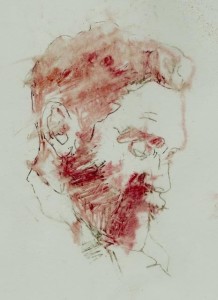By Alison Garden
O WHAT has made that sudden noise?
What on the threshold stands?
It never crossed the sea because
John Bull and the sea are friends;
But this is not the old sea
Nor this the old seashore.
What gave that roar of mockery,
That roar in the sea’s roar?
The ghost of Roger Casement
Is beating on the door.
‘The Ghost Of Roger Casement’, W.B. Yeats
Elizabeth Magill’s portrait of Casement, ‘Roger and the Swans’, is eerily evocative of Casement’s spectral afterlife. At first glance, it looks like an aged photograph, worn and ripped, with the white splashes of paint (presumably the eponymous swans) looking like areas of photographic over-exposure. Significantly, this portrait was painted not from ‘real life’, or a model sitting, but from a photograph. And so, as it seems to be with Casement, the real, the authentic, the genuine, is endlessly deferred and unavailable. Casement seems like the stuff that post-structuralist dreams are made of: the empty signifier par excellence.
[full_width]

[/full_width]
Casement’s ghost may have been beating on the door of literary and cultural history for the past 100 years, but why is he so intangible as a figure? After all, his archive extends throughout Europe, with holdings in Germany, London, Belgium and Dublin, and across the Atlantic to New York, Brazil and Peru. Indeed, so prolific a writer was he, that in 1923 William Maloney claimed ‘Casement was an extraordinary secretary bird. He kept copies of letters he sent, letters he got, things he wrote, thoughts he had’.[i] Casement has held enduring appeal for historians too, with more biographies written about Casement than any other 1916 leader and in every major European language. [ii]
Despite Casement’s own significant archival legacy, the relentless production of such biographies suggests that we still haven’t fully decided upon the definitive and conclusive ‘history of Casement’. For the Revolutionary Casement of 1916 was just one of his many guises. In his correspondence, Casement adopted aliases as varied as Tiger, Didion, Rory, Bridget, Irish Slave and the Knight Errant, indicative of an awareness that his letters were likely being intercepted and of the warm, close relationships he shared with many of his correspondents. His afterlife has seen his legacy overwritten to claim he was a seminal human rights activist; a key figure in the struggle for Irish independence; a traitor to British imperialism; and a homosexual martyr.
Casement’s lifetime achievements and activities were so vast and plural, so riddled with seeming contradictions and uncertainties, that this excess of meaning has attracted scholars and writers like moths to a flame. The mass of writing surrounding Casement, including amateur and professional history, and literary and archival material, is truly extensive, but Casement is still ‘something of an unstable text’ and the discourses that surround him are multiple and conflicting.[iii] If historians have grappled to write the conclusive narrative of Casement’s life and legacy, Casement’s literary afterlife has been decidedly spectral. Casement haunts an astonishing range of texts, from Heart of Darkness (1899) and Arthur Conan Doyle’s The Lost World (1911), to Ulysses (1922), Mario Vargas Llosa’s The Dream of the Celt (2010), Jamie O’Neill’s At Swim, Two Boys (2001), various plays (including some for radio) and innumerable poems. The ghostly quality of Casement’s literary manifestations, which are often barely recognisable as Casement at all, are fitting with what Richard Kirkland has labelled the ‘textual instability [that] dogged Casement’s life’.[iv]
[full_width]

[/full_width]
However, in the clamour of researchers to assert a definitive narrative about Casement, are we missing one of the most interesting points: namely, what Casement’s afterlife tells us about the fault lines in the relationship between Ireland, Britain and global imperial history. It could well be that the power of Casement’s legacy lies precisely in its indeterminate quality. Instead of adding to the endless debate surrounding the nuances of Casement’s life and the veracity of the ‘Black Diaries’, we might ask instead what is invested in these multiple and contradictory images of Casement and what cultural work Casement’s spectre does in its literary apparitions. Returning to the Yeats’ stanza that prefaces this post, you’ll notice how Casement’s ghost ‘on the threshold stands’, denied entry to the domestic refuge of Irish soil and history. Spectres, ghosts and haunting are indicative of an ‘obsession with the troubled interface between history and memory’, [v] pointing towards a traumatic past that will not rest. During this moment of centenaries, commemorating the history of these islands, now is the time to accept that opening the door to Casement, in all his guises, might also involve opening the door to an assortment of uncomfortable truths and silenced histories for both nations.
Alison Garden is Leverhulme Postdoctoral Fellow at University College Dublin.
[i] William Maloney to John Quinn, November 10th 1923 (Quinn Papers, New York Public Library).
[ii] Angus Mitchell, ‘Roger Casement: a man of mystery’, (http://theirishrevolution.ie/691-2/#.VvJ7w2SLSoh).
[iii] Richard Kirkland, ‘Rhetoric and (Mis)recognitions: Reading Casement’, Irish Studies Review 7:2 (1999), 163-172, p. 168.
[iv] Kirkland, ‘Rhetoric and (Mis)recognitions’, p. 170.
[v] Martin Jay, Cultural Semantics: Keywords of our Time, (London: The Athlone Press, 1998), p. 163-4.